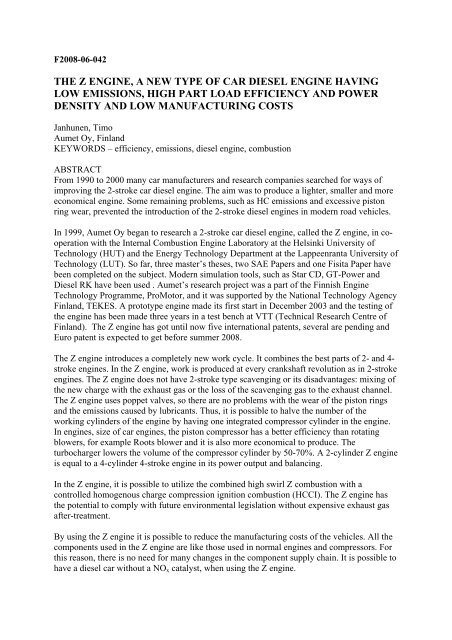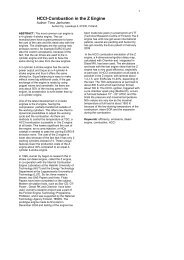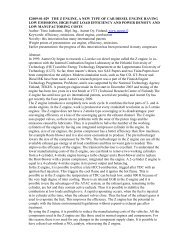THE Z ENGINE, A NEW TYPE OF CAR DIESEL ENGINE ... - Aumet Oy
THE Z ENGINE, A NEW TYPE OF CAR DIESEL ENGINE ... - Aumet Oy
THE Z ENGINE, A NEW TYPE OF CAR DIESEL ENGINE ... - Aumet Oy
You also want an ePaper? Increase the reach of your titles
YUMPU automatically turns print PDFs into web optimized ePapers that Google loves.
F2008-06-042<br />
<strong>THE</strong> Z <strong>ENGINE</strong>, A <strong>NEW</strong> <strong>TYPE</strong> <strong>OF</strong> <strong>CAR</strong> <strong>DIESEL</strong> <strong>ENGINE</strong> HAVING<br />
LOW EMISSIONS, HIGH PART LOAD EFFICIENCY AND POWER<br />
DENSITY AND LOW MANUFACTURING COSTS<br />
Janhunen, Timo<br />
<strong>Aumet</strong> <strong>Oy</strong>, Finland<br />
KEYWORDS – efficiency, emissions, diesel engine, combustion<br />
ABSTRACT<br />
From 1990 to 2000 many car manufacturers and research companies searched for ways of<br />
improving the 2-stroke car diesel engine. The aim was to produce a lighter, smaller and more<br />
economical engine. Some remaining problems, such as HC emissions and excessive piston<br />
ring wear, prevented the introduction of the 2-stroke diesel engines in modern road vehicles.<br />
In 1999, <strong>Aumet</strong> <strong>Oy</strong> began to research a 2-stroke car diesel engine, called the Z engine, in cooperation<br />
with the Internal Combustion Engine Laboratory at the Helsinki University of<br />
Technology (HUT) and the Energy Technology Department at the Lappeenranta University of<br />
Technology (LUT). So far, three master’s theses, two SAE Papers and one Fisita Paper have<br />
been completed on the subject. Modern simulation tools, such as Star CD, GT-Power and<br />
Diesel RK have been used . <strong>Aumet</strong>’s research project was a part of the Finnish Engine<br />
Technology Programme, ProMotor, and it was supported by the National Technology Agency<br />
Finland, TEKES. A prototype engine made its first start in December 2003 and the testing of<br />
the engine has been made three years in a test bench at VTT (Technical Research Centre of<br />
Finland). The Z engine has got until now five international patents, several are pending and<br />
Euro patent is expected to get before summer 2008.<br />
The Z engine introduces a completely new work cycle. It combines the best parts of 2- and 4-<br />
stroke engines. In the Z engine, work is produced at every crankshaft revolution as in 2-stroke<br />
engines. The Z engine does not have 2-stroke type scavenging or its disadvantages: mixing of<br />
the new charge with the exhaust gas or the loss of the scavenging gas to the exhaust channel.<br />
The Z engine uses poppet valves, so there are no problems with the wear of the piston rings<br />
and the emissions caused by lubricants. Thus, it is possible to halve the number of the<br />
working cylinders of the engine by having one integrated compressor cylinder in the engine.<br />
In engines, size of car engines, the piston compressor has a better efficiency than rotating<br />
blowers, for example Roots blower and it is also more economical to produce. The<br />
turbocharger lowers the volume of the compressor cylinder by 50-70%. A 2-cylinder Z engine<br />
is equal to a 4-cylinder 4-stroke engine in its power output and balancing.<br />
In the Z engine, it is possible to utilize the combined high swirl Z combustion with a<br />
controlled homogenous charge compression ignition combustion (HCCI). The Z engine has<br />
the potential to comply with future environmental legislation without expensive exhaust gas<br />
after-treatment.<br />
By using the Z engine it is possible to reduce the manufacturing costs of the vehicles. All the<br />
components used in the Z engine are like those used in normal engines and compressors. For<br />
this reason, there is no need for many changes in the component supply chain. It is possible to<br />
have a diesel car without a NOx catalyst, when using the Z engine.
TECHNICAL PAPER<br />
The Z engine contains several new features. It is a combination of a 4-stroke and a 2-stroke<br />
engine. The intake and the exhaust poppet valves are placed into the cylinder head. The Z<br />
engine doesn’t have similarities with 2-stroke engines. There is no mixing of the new charge<br />
with exhaust gas or loss of fresh air to the exhaust channel. Because the Z engine doesn’t<br />
utilize port scavenging, there are no emissions caused by lubricants getting into the cylinder<br />
from the scavenging ports and no excessive wear of the piston ring.<br />
The main principle of the Z engine is removing a part of the compression from the work<br />
cylinder to an external compressor(s). The external compression is done by a 2-stage<br />
compressor set. The first-stage compressor is a turbo charger. The second-stage compressor is<br />
a piston compressor that is integrated into the engine. There is an adjustable intercooler after<br />
each compressor stage for temperature control. The intercooling is adjusted by using bypass<br />
valves. The pressure after the external compression varies from 7 bar to 15 bar.<br />
The combustion air is conducted into the work cylinder through the poppet valves. The intake<br />
begins while the piston is approaching the top dead centre (for example around 60° BTDC)<br />
and the intake valves are open only about 20° on the crankshaft. This fast intake is possible<br />
because of the high intake manifold pressure. The final compression takes place in the work<br />
cylinder. The fuel is injected into the cylinder. The combustion is followed by the expansion<br />
stroke. The exhaust valves are opened before the bottom dead centre as in the 4-stroke<br />
engines. During the upward stroke, the piston pushes most of the combustion products out<br />
from the cylinder until the exhaust closes and the intake opens. Thus an intern EGR is<br />
possible.<br />
Figure 1: The process in the work cylinder<br />
The geometric compression ratio does not define the maximum compression temperature and<br />
pressure in the Z engine. Rather, it defines the maximum power by fixing the compression<br />
volume. The compression volume with the maximum allowed pressure and the minimum<br />
possible (auto ignition, etc.) temperature gives the mass of the combustion air and thereby<br />
defines the maximum power output. The geometric compression ratio is, for example 15,<br />
depending on the application.
Because a part of the compression occurs externally, the final compression temperature and<br />
pressure are not tied together in the Z engine. This gives the engine designer more parameters<br />
with which to optimize the engine for different load, speed and environment situations. The<br />
amount of the charge air can be altered by changing the valve timing and by controlling the<br />
intake temperature and pressure. This makes it possible to control, for example, the air/fuel<br />
equivalence ratio in a compression ignition engine. The valve timing affects the portion of the<br />
compression done in the work cylinder and also to the internal EGR. It is useful to shift more<br />
compression to the work cylinder for example at part loads.<br />
The Z engine can also utilize the Otto cycle. The knock phenomenon found at high<br />
geometrical compression ratios and pressures when using gasoline fuel can be avoided,<br />
because the compression temperature can be controlled separately. A higher overall efficiency<br />
could be gained because of the higher compression ratio and better controllability especially<br />
at part loads.<br />
<strong>THE</strong> HIGH SWIRL Z COMBUSTION<br />
The high intake pressure enables this new combustion method in the Z engine. The maximum<br />
transient speed of the intake air coming into the cylinder is over 500 m/s depending on the<br />
intake pressure and the valve geometry. By directing this high-speed air tangentially into the<br />
cylinder, a very high swirl can be achieved. The swirl number of the new charge can be, for<br />
example, 20. The turbulence energy in the cylinder is very high, about ten times higher than<br />
in the common diesel engines due to the high intake velocity.<br />
A schematic picture of the intake valve of the Z combustion system can be seen in Figure 2.<br />
The flow is held back in a certain sector of the valve to prevent the air flowing backwards into<br />
the swirl. Shrouds are used in the figure for this purpose, but some other methods have been<br />
utilized in the prototype engine and in future developments. To enable a supersonic flow, the<br />
valve is designed to form a Laval-type narrowing/widening nozzle while it is open.<br />
.<br />
Figure 2: Valve design
The theoretical flow behaviour in the valves can be seen in Figure 3 The pressure difference<br />
has been received from a simulation of the engine. The required ratio between the exit area of<br />
the valves and the throat (at the inner seat) area has been calculated from the flow speed and<br />
the specific volume of the flow. The calculated exit area/throat area ratio has been calculated<br />
from the valve lift data and the valve dimensions. The intern exhaust gas re circulation (EGR)<br />
rate was 20% and the exhaust gas was not rotating at the beginning of the gas exchange.<br />
Figure 3: The theoretical valve flow<br />
Figure 4: The heat insulated combustion chamber<br />
The fuel injector can have a hollow cone shape, forming a pintle nozzle injector like that used<br />
in gasoline injection systems. This type of injector has been used also in the swirl-chamber<br />
diesel-combustion systems. For example, the CAV Microjector, Figure 5, is an injector of this<br />
type, which was used in some USA-made swirl-chamber engines in the 80s. These injectors<br />
have good atomisation without needing a high fuel pressure. This makes the fuel injection<br />
system easier to manufacture and more cost effective. This kind of nozzle has no sac volume<br />
and there are no hydrocarbon emissions caused by fuel evaporation from the sac volume. The
low injection pressure, only 500 bar, increases the efficiency of the engine by 1,5-2%<br />
compared to engines using 1600-2000 bar.<br />
Figure 5: CAV Microjector injector<br />
The NOx measurements of the Z combustion was in made December 2006 at VTT laboratory<br />
in Finland. At part load NOx was 0,8 g/kWh and the efficiency was 35%.<br />
In order to reduce still NOx, it was further developed a new type of combustion, a<br />
combination of Z combustion and late HCCI combustion. The fuel injection of the HCCI<br />
combustion occurs at about 60° BTDC, when the temperature is about 700K and the pressure<br />
is about 2-3 bar. This rapid transient area in the gas exchange of the Z engine makes a very<br />
rapid evaporation of the droplets possible. The fuel injection to the hot, heat insulated<br />
combustion chamber at 5° ATDC ignites the HCCI mixture at 10° ATDC. Enclosed the<br />
temperature- and pressure curves between 80°-40° BTDC.<br />
p (bar)<br />
16<br />
13<br />
10<br />
7<br />
4<br />
1<br />
280 290 300 310 320<br />
deg<br />
Figure 6: The temperature- and pressure curves between 80°-40° BTD<br />
T (K)<br />
720<br />
660<br />
600<br />
540<br />
280 290 300 310 320<br />
deg
Enclosed picture of the HCCI injection<br />
HCCI injection starts 55° BDTC HCCI injection ends 50° BDTC<br />
Figure 7: The HCCI injection<br />
Enclosed picture of the Z injection<br />
Z combustion ignites homogenous mixture 10° ATDC<br />
Figure 8: The Z injection<br />
Enclosed the piston of the new Z-HCCI combustion<br />
Figure 9: The new piston
The combined Z-HCCI –combustion makes a late HCCI-combustion possible, as the<br />
compression temperature at TDC do not exceed 800 K and thus the HCCI mixture don’t self<br />
ignite. By this way it is possible to trigger the ignition of the HCCI-mixture at 10° ATDC.<br />
From this point the down wards moving piston lowers the pressure- and temperature rise<br />
during the HCCI-combustion. The slow Z-combustion acts as a pneumatic dumper during the<br />
HCCI-combustion. Enclosed the comparison between the split-combustion and the Z-HCCIcombustion<br />
ROHR [J/Deg]<br />
T [K]<br />
p [MPa]<br />
250<br />
200<br />
150<br />
100<br />
50<br />
0<br />
2000<br />
1500<br />
1000<br />
20<br />
16<br />
12<br />
500<br />
8<br />
4<br />
0<br />
-40 -20 0 20 40 60 80 100<br />
Degrees<br />
-40 -20 0 20 40 60 80 100<br />
Degrees<br />
-40 -20 0 20 40 60 80 100<br />
Degrees<br />
Figure 10: Comparison of Split-combustion and Z-HCCI-combustion<br />
In order to enhance the air-fuel vapour mixing, the piston is equipped with three ribs to brake<br />
down the high swirl at TDC and to convert it to a high turbulence. This lowers the heat losses<br />
close to TDC during the HCCI-combustion. The high swirl stays anyhow in the heat insulated<br />
Z-combustion chamber in the middle of the piston.<br />
Compared with the Split-combustion, the combined Z-HCCI-combustion offers following<br />
advantages:<br />
- higher efficiency<br />
- lower heath losses<br />
- better mechanical efficiency<br />
- lower EGR, 20%<br />
- work at every piston stroke in the Z-engine<br />
- higher BMEP<br />
ROHR [J/Deg]<br />
p (Mpa)<br />
300<br />
240<br />
180<br />
120<br />
60<br />
0<br />
2000<br />
1500<br />
1000<br />
500<br />
20<br />
16<br />
12<br />
-40 -20 0 20 40 60 80 100<br />
Degrees<br />
8<br />
4<br />
0<br />
-40 -20 0 20 40 60 80 100<br />
Degrees<br />
-40 -20 0 20 40 60 80 100<br />
Degrees
- easy ignition control of the HCCI-combustion<br />
- late HCCI-combustion possible<br />
- very low NOx in the HCCI combustion<br />
- low NOx in the Z-combustion (deNOx phenomena)<br />
- low injection pressure, 200 – 300 bar<br />
- injection rate at part load 95/5<br />
- injection rate at full load 70/30<br />
- NOx at full load 0,25 g/kWh<br />
- NOx at part load 0,05 g/kWh<br />
The test of this new combustion system shall be performed during summer 2008 at VTT in<br />
Finland. The combustion system has been simulated with Diesel RK.<br />
Z-<strong>ENGINE</strong>, AN ECONOMICAL ALTERNATIVE TO A HYBRID SYSTEM<br />
Figure 11: The Z-engine, 2-cyl, 1 l, 100 kW / 4000 rpm
References:<br />
Control of the Start of HCCI Combustion by Pulsed Flame Jet, SAE 2002-01-2867<br />
Investigations on Pre-Chamber Spark Plug with Pilot Injection, SAE 2007-01-0479<br />
Advances in Diesel Engine Combustion: Split Combustion, SAE 2007-01-0178<br />
Adaptive Injection Strategies (AIS) for Ultra-Low Emissions Diesel Engines, DEER 2007<br />
Experimentelle und theoretische Untersuchung homogener und teilhomogener<br />
Dieselbrennverfahren, Stuttgart 2007<br />
Zum Verhalten des Dieseleinspritzstrahles in einem Luftwirbel, Graz 1997<br />
Über die Dieselverbrennung bei Einspritzung aus dem Zentrum eines Luftwirbels, Graz 1997<br />
A Study of NO Reduction Caused by Thermal Cracking Hydrocarbons during Rich Diesel<br />
Combustion. JSME International Journal No 2, 2006, Noge, Kidoguchi, Miwa<br />
Sami Nyyssönen, Lappeenranta 2001: Optimisation of Thermodynamics and Flow<br />
Mechanism of a new type 2-stroke Engine, Supervisor Prof. Jaakko Larjola, Lappeenranta<br />
University of Technology.<br />
Sami Hörkkö, Espoo 2002: Preconditions for Fuel Ignition and Combustion in a New Type<br />
Diesel Engine, Supervisor Prof. D.Sc. (Tech.) Martti Larmi, Helsinki University of<br />
Technology.<br />
Tore Grönlund, Espoo 2003: Valve Train of a New Type Engine, Supervisor Prof. D.Sc.<br />
(Tech.) Martti Larmi, Helsinki University of Technology.<br />
Larmi M., Tiainen T., Saarinen A., Grönlund T.: "Novel two-stroke engine concept,<br />
feasibility study", SAE Paper No: 2003-01-3211, Helsinki University of Technology.:<br />
Larmi M., Grönlund T.: “Valve train design for a new gas exchange process” SAE Paper No:<br />
2004-01-0607, Helsinki University of Technology.<br />
By using the Z engine, it is possible to reduce the manufacturing costs of vehicles. All the<br />
components used in the Z engine are similar to those used in common engines and<br />
compressors. For this reason, there is no need to make many changes to the component supply<br />
chain. It is possible to have a diesel passenger car without the NOx catalyst, when using the Z<br />
engine.








